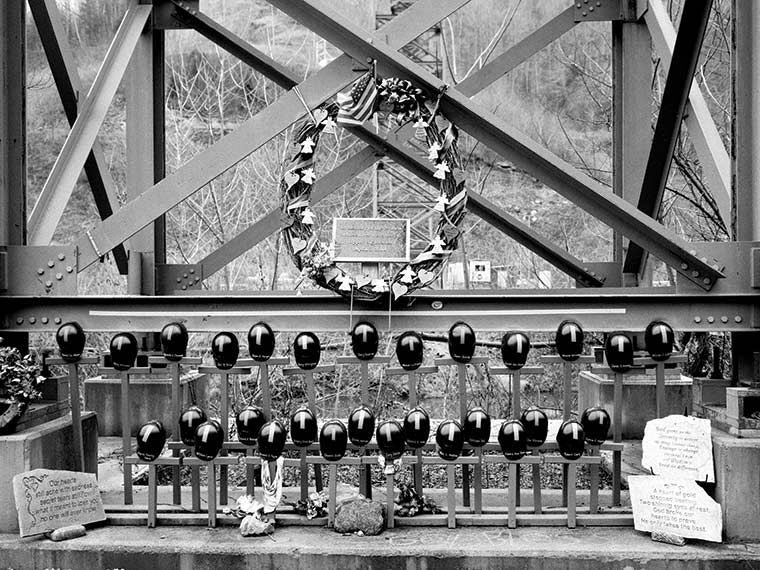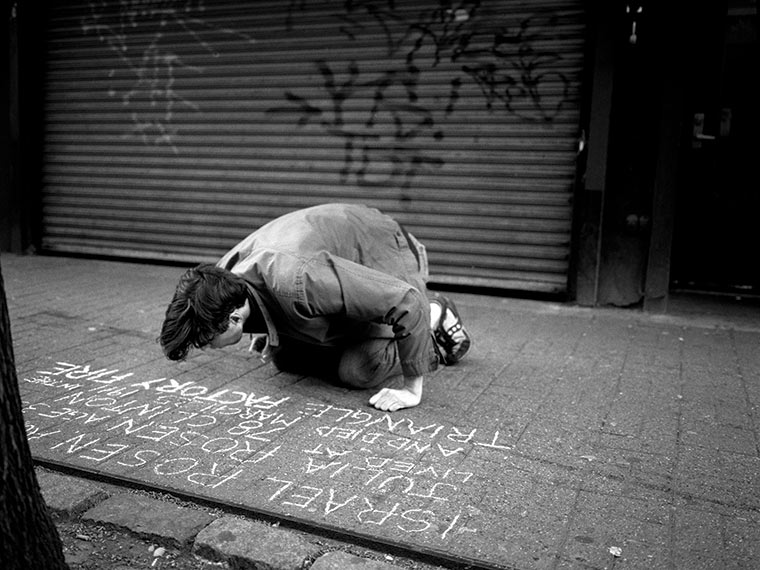
Over the past two decades, independent photojournalist Andrew Lichtenstein ’88 has focused his lens on long-term stories about social justice in America. His monograph Marked, Unmarked, Remembered presents photographs of significant sites from United States history, posing unsettling questions about the contested memory of traumatic episodes from the nation’s past. “The photographs I’ve taken, and continue to search for, are as much about what is here now, in the 21st century, as they are about an elusive past,” he explains.* “I’m interested in a history of violence and conquest, and the struggle for freedom and equality, because I see these themes as very much still with us today.”
Images in the final section of the book, “Remembered,” capture local efforts to commemorate crucial events in the face of official disinterest or denial. “In contrast to government- or chamber of commerce-approved forms of heritage,” notes co-author and historian Alex Lichtenstein (brother) in the introduction, “these images represent an unselfconscious grassroots desire to connect a painful past to the present.”
Reading of the Emancipation Proclamation
Galveston, Texas | 2010

With the Emancipation Proclamation, President Abraham Lincoln declared slaves in the rebellious Confederate States to be free as of January 1, 1863. In the state of Texas, nearly 200,000 enslaved African Americans had to wait until June 19, 1865, for the enforcement of their liberation, when Union Major General Gordon Granger finally read the Proclamation from the balcony of a Galveston mansion. By combining the words "June" and "Nineteenth," local black families made the event a festive holiday to celebrate their freedom. Today Juneteenth is the oldest known event commemorating the end of slavery in America.
Manzanar War Relocation Center
Independence, California | 2012

Every year Japanese Americans organize a pilgrimage to the partially restored Manzanar Japanese internment camp to remember President Roosevelt's wartime Executive Order 9066, which in early 1942 set the stage for the imprisonment of more than 110,000 people of Japanese descent, two thirds of them American citizens. Aiko Morimoto, 83, who lived in the Topaz camp in Utah as a young girl, sits on a cot in a cabin designed to recreate the barracks at Manzanar. "It is good they have built this," she said. "But it is not the same. The dust, the bugs, the heat ... no one would come visit if it were really the same."
Prayer for the Ancestors
Rockaway Beach, Queens, New York | 2010

By some estimates, upwards of 12 million Africans were kidnapped and forced onto ships headed to the New World to be sold as slaves. Millions died on the journey. Every September, parishioners from St. Paul's Community Baptist Church in East New York, Brooklyn, remember this holocaust by offering a prayer to their ancestors who died on these slave ships crossing the Atlantic Ocean. Hundreds of worshippers, wearing white, attend a dawn ceremony at the western edge of the Atlantic Ocean in Rockaway Beach, Queens.
Upper Big Branch Mine Memorial
Whitesville, West Virginia | 2015

Under the leadership of its anti-union CEO, Don Blankenship, Massey Energy operated its West Virginia coal mines more like a criminal enterprise than a federally regulated industrial company. In the drive for profits, and in a relentless effort to extract as much coal from the ground as quickly as possible, Massey routinely flouted environmental and safety regulations. On April 5, 2010, Massey's Upper Big Branch Mine exploded, killing 29 miners. Local residents and family members of the miners have left flowers and other mementos to honor the dead at the now-closed entrance to the mine.
Black Seminole Scouts Association Reunion
Brackettville, Texas | 2014

During the 18th and 19th centuries, slaves from the plantations of South Carolina and Georgia escaped into the wilds of Spanish Florida and joined the Seminole Indian tribe, becoming full tribal members and valued warriors. Like most of the other southeastern Indian tribes, the Seminoles were forced into a brutal trek to Oklahoma in the 1840s. Once there, however, whites raided the reservation to kidnap darker-skinned former slaves and sell them back into slavery. Under the leadership of Black Seminole warrior John Horse, many fled to Mexico. After the Civil War, some of the Black Seminoles returned to the United States when they were offered jobs as cavalry scouts along the Texas border. These men and women fought and survived across the expanding frontier, redefining what it meant to be African, Indian, and American. Every year descendants of the Black Seminole Scouts hold a barbecue reunion in memory of their ancestors.
Remembering Victims of the Triangle Shirtwaist Fire
New York City, New York | 2010

On March 25, 1911, the Triangle Shirtwaist Factory in New York City caught fire. One hundred forty-six garment workers trapped on the upper floors of the building died, many of them leaping to the pavement below. The stairway and exit doors had been locked to keep the mostly young, underpaid Jewish and Italian women workers on their sewing machines without a break. Every year, on the anniversary of the fire, a small group of volunteers chalks the names of the victims on city sidewalks in front of the Lower East Side addresses where the women had lived.
Memorial for Michael Brown Jr.
Ferguson, Missouri | 2014

When the body of teenager Michael Brown Jr. was finally removed from the suburban street where he was shot to death by a police officer in August 2014, mourners spontaneously began leaving offerings of stuffed animals, flowers, balloons, baseball caps, and candles. Rebuilt multiple times, the iconic shrines on Canfield Drive were formally removed on his birthday the following May, with the blessing of his family. Even before plans for a permanent memorial started to take shape, neighborhood resident Markese Mull told the St. Louis Post-Dispatch that the site had become sacred. “Instead of a stain on the pavement,” he said, “Michael Brown needs to be a mark on history.”
Photos and text excerpted from the book Marked, Unmarked, Remembered by photographer, journalist, and educator Andrew Lichtenstein ’88 with professor, editor, and historian Alex Lichtenstein
Published by West Virginia University Press (2017)
As Andrew’s photographs suggest, the confluence of landscape, event, and memory is no simple doorway into an unmediated past.—Historian Alex Lichtenstein
Main image: Andrew Lichtenstein ’88 in the US Capitol Rotunda, seated beneath the painting Baptism of Pocahontas, between busts of Martin Luther King, Jr. and President Thomas Jefferson on the night of President Trump’s impeachment.
I’ve always believed that the first step toward healing a deep wound is acknowledgment.—Photojournalist Andrew Lichtenstein ’88
*Quoted from Andrew Lichtenstein’s artist’s statement for his photo series, American Memory, created with grant support from The Aftermath Project, a nonprofit organization “committed to telling the other half of the story of conflict.”